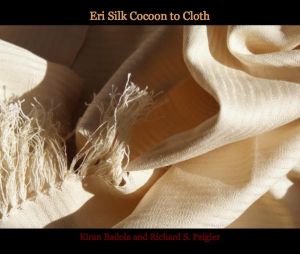
Contents: 1. Introduction. 2. Sericulture. 3. Eri silk around the world. 4. Scarves with specs. 5. Glossary. 6. Acknowledgements. 7. Bibliography. 8. About the authors.
From the introduction: Eri Silk a staple fiber unlike some other silks that are processed as a continuous filament. It is warm during winter and cool during summer. The look and feel of eri silk closely approximates that of cotton and it is spun and woven in much the same ways as cotton and wool. Eri silk is rarely reeled. The fibers in the cocoon are like a tiny bale of cotton, all wound together and tangled, so spun Eri silk has a very unusual quality. Depending on how it is spun and woven, it can give a very woolly result, or a tight strong fiber like linen. As Mclaughlin 2009 put it is protein based fiber that behaves in spinning and weaving like a cellulose based one. The aforementioned features make Eri textiles unique.
Eri silk is heavier than other silks and blends well with wool and cotton. Due to its amazing thermal properties, it is warm and insulating like cotton or wool. the very properties unique to Eri silk were an inspiration to create this book. A comprehensive approach to the life cycle of the Eri moth is explained below. Eri Silk woven products have been made in great diversity, some of which are showcased in this book.